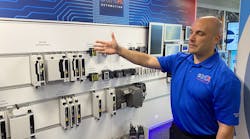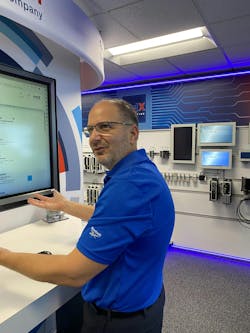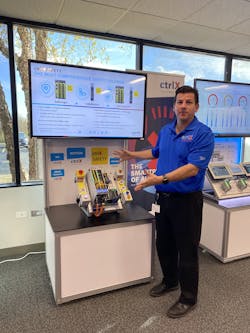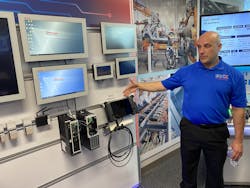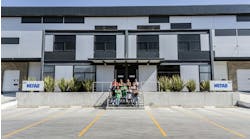Bosch Rexroth’s ctrlX automation system was launched in 2020 and began growing into an industrial ecosystem within a year. The ctrlX operating system became the center of that ecosystem in 2022.
“We started this journey in 2020,” says Dave Cameron, Bosch Rexroth director of sales, who acted as the primary host, along with his colleagues, during a visit to the automation company’s facility in Hoffman Estates, Illinois. “We’ve had milestones along the way. Because the product portfolio is so broad, it brings us many years of offering things to the marketplace.”
The ecosystem, called ctrlX World, is important, notes Cameron. “Last year we announced the first idea of ctrlX OS, the operating system that is available outside the hardware that shows up in the box,” he says. “We’re up to 1,500 customers worldwide in various applications.”
At this point, more than 1,500 Bosch Rexroth customers are using ctrlX automation, and a new warehouse in Lohr, Germany, equipped with ctrlX automation, has tripled Bosch Rexroth capacity. A new servo-motor plant opened in Brnik, Slovenia, earlier this year.
“We’ve invested in our home warehouse in Lohr, Germany, and tripled capacity, automated with ctrlX automation,” says Cameron. “We’ve always had a plant in Slovenia but added a new servo-motor production plant in Brnik, Slovenia. It’s partially opened and will be fully operational in 2024.”
The automation portfolio includes:
- ctrlX Works engineering software toolbox
- ctrlX OS operating system
- ctrlX PLC products
- ctrlX IOT for Internet of Things
- ctrlX Motion for robotics and CNC applications
- ctrlX Drive systems
- ctrlX Flow motion systems
- ctrlX Services
- ctrlX Safety
- ctrlX Core
- ctrlX I/O
- ctrlX IPC
- ctrlX HMI.
“When we started this portfolio, our approach was to address the market with familiarity of apps and the connectivity that goes on in the industrial space,” says Cameron (Figure 1). “The apps are talking to the control as the hub.”
CtrlX OS is hardware-independent and industrial-grade. Its features include real-time Linux, open standards, low-code/no-code, seamless Internet-of-Things integration and remote-device administration capabilities.
Already part of the industrial landscape, ctrlX is the operating system used by Dell and Nokia for server and cloud applications and by Wago for edge and industrial-PC applications.
“We have three partnerships,” explains Cameron. “Wago was the first, and then Nokia and Dell, who are using the ctrlX OS and offering it in the industrial space. It doesn’t necessarily live in the controls on the machine, but it’s offered in the industrial space to other suppliers.”
CtrlX Drives was conceived with flexible machine design in mind. CtrlX Drives is IP-65, cabinet- free technology, explains Joaquin Ocampo, product manager for drives at Bosch Rexroth (Figure 2). “We’ve been in the market with cabinet-free technology,” he says. “The arrangement could be line, star, group or distributed. If you have an in-cabinet design, you can easily convert it to cabinet-free design. We will support all our features. We will have encoder extensions. This will be released in 2024.”
Cabinet-free means a smaller footprint, explains Ocampo. “Another is we’ve been very successful with cable management,” he says. “This means fewer cables coming out of the cabinet and safety signals on one cable coming out of the cabinet.”
The ctrlX platform is in its third generation, notes Cameron. “We’re adapting the advantages of the ctrlX family. The advantages are still there for the cabinet with less thermal management necessary,” he says.
Data is key in the ctrlX ecosystem. “Not everyone is interested in pushing data up to a cloud,” explains Ed Polzin, product manager, controls, Bosch Rexroth. “We’ll introduce the additional storage module.”
Bosch Rexroth also is working with different artificial-intelligence (AI) partners, some focusing on bin picking, says Mike Mueller, product management leader, factory automation, at Bosch Rexroth.
CtrlX World is fast closing in on 100 partners. “They’ll provide instructions on how to insert the application into the system to make it as simple as possible,” notes Polzin. More than 25 new partners were added in 2023.
“We designed the system for utilizing apps,” notes Cameron. “Multiple things work together seamlessly. In the old days, it was necessary to download drivers that needed to be managed. It’s built on Linux. All apps talk on a data layer. And it’s encrypted, so everything is secure. In the past, the PLC layer had to manage everything.”
Each app is containerized, so it talks through the data layer, explains Mueller. “The goal was to take what people are used to—a smart phone—and translate to the industrial sector,” he says.
CtrlX World has more than 150 use cases that partners cover. From machine data extraction and vision and image recognition to increased OEE and MES integration, the list continues to grow. “We have an app validation team,” says Polzin. “If you want to get it listed on our store, it has to go through our team. It has to go through a security analysis and use cases, making analysis to see if you have the maximum throughput. Are you using energy effectively? Data collected can be used for analysis. Any information is within the data layer. You can use it as you need. It’s there. No extra programming is needed. The developer can use the app that’s comfortable or appropriate for them. The user has choices.”
All of the tools are web-based. One noteworthy partner is Kuka, whose KUKA.PLC mxAutomation is integrated in the PLC app library. The core has a PLC app which is CoDeSys-based, explains Polzin (Figure 3). “We can bring that library in the CoDeSys environment and control the Kuka robot,” he says.
“End users also can write their own apps, but they’re for their own use and not offered on ctrlX World,” explains Cameron. “Typically it’s the machine designer that we’re selling it to and using it. We have a few people who say they’ve written something cool and people talk about offering an app. We would certify it if we like it and offer it. There have been discussions.”
CtrlX Flow is a smart conveyance system, explains Cameron. Its eight unique features include:
- simultaneous rotating, moving and tilting
- safe vertical and overhead application
- large levitation height up to 20 mm
- wide tilt angle range of 10 degrees
- wireless connected mover with power and data
- no heating of tile surface
- low power consumption independent of payload
- safe handling of movers.
CtrlX FlowHS is the high-speed linear motion system for transport and positioning,” explains Cameron. “It’s ctrlX-controlled, has flexible topology and is plug-and-play. It’s a modular build, like a slot-car track.” The payload is 2.5 kg/carrier. “This is intended for specific applications with a maximum of around 5 kg of payload,” explains Cameron. The first reveal of ctrlX FlowHS was at SPS with release in 2024. “They’ll keep adding feature sets into 2025,” he notes.
“The HS has physical touch points, not levitation,” explains Cameron. “It still uses magnetics in a servo sense. It’s a linear motor. It’s like a servo motor. You can run it at any speed. Think of this as a linear motor. You can idle it. The whole system works that way. The carriers move along in full control. The controller tells it. It’s a programmatic approach with a traffic-cop management. You can synchronize robots externally with the power of the control. The ctrlX core controller is managing that. The toolbox is there to manage specifically ctrlX FlowHS.”
